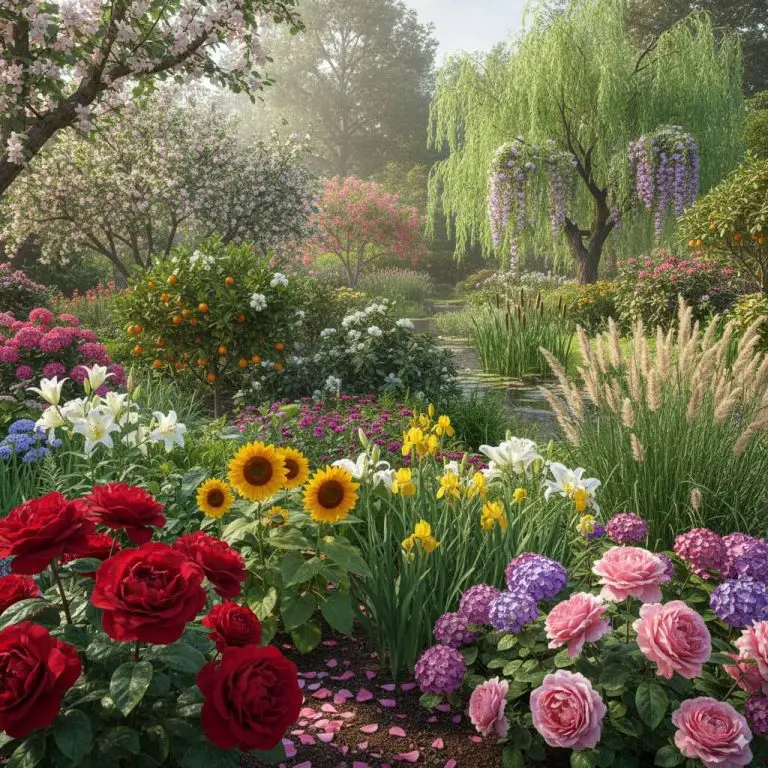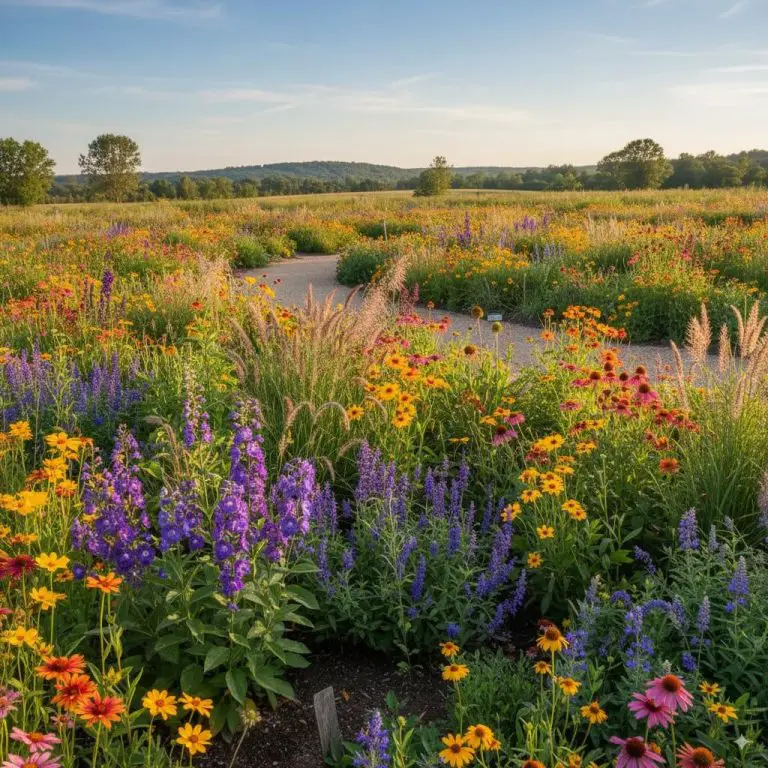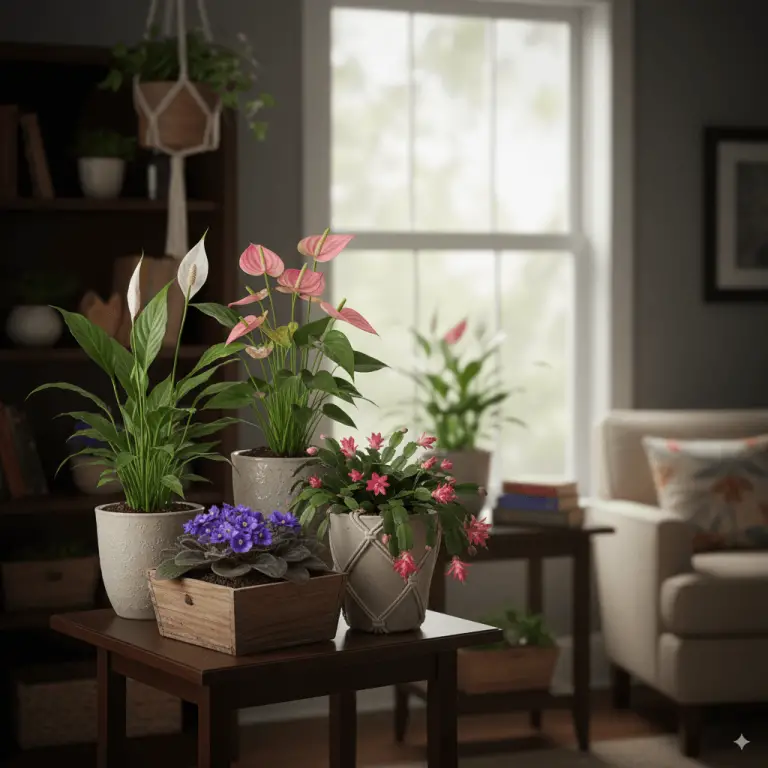20 Examples Of Flowering Plants – Your Ultimate Guide To A Vibrant Garden
Staring at a bare patch in your garden, wondering how to fill it with vibrant, long-lasting color? You’re not alone. Choosing the right flowers can feel overwhelming, with countless options vying for your attention at the garden center.
The secret to a stunning garden isn’t just picking pretty flowers; it’s about choosing the right plants that will thrive in your specific conditions and reward you with a season-long spectacle.
Imagine stepping outside to a garden bursting with life, attracting beautiful butterflies and busy bees, and offering a dazzling display from the first blush of spring to the crisp days of fall. This is completely achievable, and we’re here to show you how.
We’ve created this definitive guide to **20 examples of flowering plants** to take the guesswork out of gardening. Let’s dig in and find the perfect blooms to bring your garden dreams to life!
## Why Add These Flowering Plants to Your Garden? The Surprising Benefits

🌿 The Companion Planting & Gardening Book (eBook)
Bigger harvests, fewer pests — natural pairings & simple layouts. $2.40
Get – $2.40
🪴 The Pest-Free Indoor Garden (eBook)
DIY sprays & soil tips for bug-free houseplants. $1.99
Get – $1.99Beyond their obvious beauty, incorporating a diverse range of flowering plants into your landscape offers a wealth of advantages. This isn’t just about aesthetics; it’s about creating a healthier, more dynamic ecosystem right outside your door. Understanding the benefits of 20 examples of flowering plants can transform your perspective on gardening.
Here’s what you stand to gain:
- Attract Pollinators: Many flowers, like Coneflowers and Salvia, are magnets for bees, butterflies, and hummingbirds. These pollinators are essential for a healthy environment and for helping your vegetable garden produce fruit.
- Boost Curb Appeal: A well-planned garden filled with colorful blooms dramatically increases the visual appeal and even the value of your home. It creates a welcoming and cheerful first impression.
- Improve Mental Well-being: The act of gardening and being surrounded by natural beauty is a proven stress-reliever. It connects you with nature and provides a fulfilling sense of accomplishment.
- Create a Sustainable Habitat: By choosing a variety of plants, especially native ones, you provide food and shelter for local wildlife, contributing to a more balanced and sustainable backyard ecosystem.
## Our Top 20 Examples of Flowering Plants for Every Garden
Ready for the fun part? This list is your starting point for a garden that dazzles. We’ve broken down our top 20 picks into easy-to-navigate categories, making it simple to find the right plant for the right spot. This is your ultimate **20 examples of flowering plants guide**!
Sun-Loving Annuals (Easy & Colorful)
Annuals complete their life cycle in one year, making them perfect for adding instant, powerful color to beds and containers. Perfect for beginners!
- Marigold (Tagetes): A classic for a reason! These cheerful flowers in shades of orange, yellow, and red are incredibly easy to grow and are known for deterring pests.
- Zinnia (Zinnia elegans): Zinnias are the definition of cheerful. They come in a rainbow of colors, love the heat, and are fantastic cut flowers. The more you cut, the more they bloom!
- Petunia (Petunia x atkinsiana): These prolific bloomers are perfect for hanging baskets, window boxes, and container gardens, spilling over the edges with color.
- Sunflower (Helianthus annuus): Nothing says summer like a towering sunflower. They are incredibly easy to grow from seed and are a favorite of kids and pollinators alike.
Shade-Tolerant Beauties
Have a shady spot? No problem! These plants thrive in lower light conditions, bringing color and texture to the darker corners of your garden.
- Impatiens (Impatiens walleriana): The ultimate shade-loving annual. Impatiens provide mounds of continuous color in white, pink, red, and purple all season long.
- Begonia (Begonia semperflorens-cultorum): With waxy leaves and delicate flowers, begonias are workhorses in the shade garden, tolerating a range of conditions.
- Hosta (Hosta): While primarily grown for their stunning foliage, Hostas produce elegant spikes of lavender or white flowers in mid-summer that are beloved by hummingbirds.
- Astilbe (Astilbe): Known for their feathery, plume-like flowers in shades of pink, red, and white, Astilbes add a unique texture and grace to shady, moist areas.
Hardy Perennials (Come Back Every Year!)
Perennials are the backbone of a garden. You plant them once, and they return year after year, often growing bigger and better with time.
- Coneflower (Echinacea purpurea): A tough, drought-tolerant native plant with iconic purple-pink, daisy-like flowers. They are a favorite of goldfinches and butterflies.
- Black-Eyed Susan (Rudbeckia hirta): These golden-yellow flowers with dark brown centers provide a brilliant splash of late-summer color and are incredibly low-maintenance.
- Lavender (Lavandula): Prized for its calming fragrance and beautiful purple flower spikes, lavender loves full sun and well-drained soil. You can do this!
- Daylily (Hemerocallis): One of the most adaptable perennials you can grow. Each flower lasts only a day, but they produce so many buds that the show lasts for weeks.
- Peony (Paeonia): Known for their enormous, fragrant, and romantic blooms in late spring. Peonies are long-lived plants that can thrive for decades with minimal care.
Stunning Shrubs and Climbers
These plants provide vertical interest and structure, creating a lush, multi-layered garden.
- Rose (Rosa): From hardy shrub roses to elegant climbing varieties, there is a rose for every garden. Their timeless beauty and fragrance are unmatched.
- Hydrangea (Hydrangea): Famous for their large, showy flower heads in shades of blue, pink, white, and green. Different varieties are suited for sun or part shade.
- Clematis (Clematis): A beautiful flowering vine often called the “Queen of Climbers.” They love to have their “feet in the shade and heads in the sun.”
- Lilac (Syringa vulgaris): The intoxicating scent of lilac blossoms is a sure sign of spring. These hardy shrubs are low-maintenance and long-lived.
Unique and Interesting Blooms
Looking for something a little different? These flowers add a “wow” factor with their unique shapes and vibrant colors.
- Salvia (Salvia): With tall, elegant spikes of flowers, often in shades of purple, blue, and red, Salvia is a magnet for hummingbirds and bees.
- Dahlia (Dahlia): Dahlias offer an incredible diversity of flower shapes, sizes, and colors. From small pom-poms to giant “dinner-plate” blooms, they are true showstoppers.
- Foxglove (Digitalis purpurea): These tall, dramatic plants produce spires of bell-shaped flowers, adding a touch of fairytale whimsy to the garden.
## A Practical Care Guide for Your Flowering Plants
Growing beautiful flowers is easier than you think! Success comes down to a few key principles. This **20 examples of flowering plants care guide** follows the best practices to ensure your garden thrives.
Sunlight: The Fuel for Flowers
Pay close attention to sun requirements. Full sun means 6+ hours of direct sunlight per day (perfect for Sunflowers, Zinnias). Part sun/shade means about 3-6 hours of sun, preferably morning sun (ideal for Hydrangeas, Astilbes). Shade means less than 3 hours of direct sun (where Impatiens and Hostas shine).
Watering Wisely: The Golden Rule
Most flowering plants prefer deep, infrequent watering over a light daily sprinkle. This encourages deep root growth. Check the soil with your finger; if it’s dry an inch or two down, it’s time to water. Water the base of the plant, not the leaves, to prevent disease.
Soil and Feeding: Building a Strong Foundation
Healthy plants start with healthy soil. Most flowers thrive in well-draining soil amended with compost. Compost adds vital nutrients and improves soil structure. A balanced, all-purpose flower fertilizer applied according to package directions can give your plants an extra boost during the growing season.
Pruning and Deadheading for More Blooms
This is a game-changing tip! Deadheading is the simple act of removing spent or faded flowers. For plants like Petunias, Zinnias, and Marigolds, this tricks the plant into producing more flowers instead of putting energy into making seeds. It keeps your garden looking tidy and full of blooms!
## Common Problems with Flowering Plants (And How to Solve Them!)
Even the best gardeners face challenges. Don’t be discouraged! Here’s a look at some **common problems with 20 examples of flowering plants** and simple, effective solutions.
Pesky Pests: Aphids, Slugs, and More
Aphids often gather on new growth. A strong spray of water from the hose can dislodge them, or you can use an insecticidal soap. For slugs, try placing a shallow dish of beer near affected plants or use eco-friendly slug bait.
Fungal Foes: Powdery Mildew and Black Spot
These issues often appear in humid conditions. The best defense is a good offense. Ensure your plants have good air circulation (don’t overcrowd them) and water the soil, not the foliage. If you see signs of fungus, remove the affected leaves immediately.
Why Aren’t My Plants Blooming?
This is a common frustration. The top three culprits are usually:
- Not enough sun: A sun-loving plant like a Rose won’t bloom well in the shade.
- Too much nitrogen fertilizer: Nitrogen promotes leafy green growth at the expense of flowers. Use a balanced fertilizer or one higher in phosphorus.
- Improper pruning: Some shrubs, like Lilacs, bloom on old wood. Pruning them at the wrong time of year can remove next year’s flower buds.
## Sustainable Practices for Your Flowering Garden
A beautiful garden can also be an environmentally friendly one. Embracing **sustainable 20 examples of flowering plants best practices** helps conserve resources and supports local wildlife.
Choosing Native Plants
Plants like Coneflower and Black-Eyed Susan are native to North America. They are adapted to the local climate, require less water, and provide essential food for native pollinators.
Water Conservation Techniques
Apply a 2-3 inch layer of mulch (like shredded bark or compost) around your plants. Mulch helps retain soil moisture, reduces watering needs, and suppresses weeds. Watering early in the morning also reduces evaporation.
Composting for Healthy Soil
Start a compost pile with kitchen scraps and yard waste. In a few months, you’ll have nutrient-rich “black gold” to feed your soil for free. It’s the ultimate recycling program for your garden!
## FAQs on 20 Examples of Flowering Plants
What are the easiest flowering plants for a total beginner?
For a beginner, you can’t go wrong with Sunflowers, Zinnias, and Marigolds. They are incredibly forgiving, grow quickly from seed, and provide a huge color payoff for very little effort. You’ve got this!
How do I know if a plant is an annual or a perennial?
An annual (like a Petunia) completes its entire life cycle—from seed to flower to seed—in one growing season and then dies. A perennial (like a Daylily) lives for more than two years, typically dying back to the ground in winter and re-sprouting from its roots in the spring.
What does “deadheading” mean and why is it important?
Deadheading is the process of trimming or pinching off old, faded flowers from a plant. This is crucial because it stops the plant from producing seeds and redirects its energy into creating more blooms, extending the flowering season significantly.
Can I grow these flowering plants in containers?
Absolutely! Many plants on this list are fantastic for containers. Petunias, Begonias, Salvia, and Marigolds are excellent choices for pots and window boxes. Just be sure to use a quality potting mix and remember that container plants may need to be watered more frequently.
## Your Vibrant Garden Awaits
There you have it—a complete guide to **20 examples of flowering plants** that can transform any space into a floral paradise. A beautiful garden isn’t an exclusive club for experts; it’s accessible to anyone with a little bit of soil, a splash of sunshine, and a desire to grow.
Don’t feel like you need to plant everything at once. Start with one or two that caught your eye. Get your hands dirty, watch them grow, and learn as you go. The greatest joy in gardening is the journey itself.
Now, go forth and grow!
- Insecticidal Super Soap – Your Ultimate Guide To Eco-Friendly Pest - December 12, 2025
- What Can Happen If You Eat Mold – A Gardener’S Guide To Food Safety & - December 12, 2025
- Nutrients And Plant Growth – Unlock Your Garden’S Full Potential With - December 12, 2025



